6th International Conference on Microelectronics
for Neural Networks, Evolutionary & Fuzzy Systems
 University of Technology Dresden
University of Technology Dresden 
24-26 th September 1997 at Dresden, F.R. Germany
Sponsored by
IEEE German Section
Society of Information Technology (ITG)
IMPACTS, NL-Groningen
Overview of MicroNeuro'97:
Conference Scope and Topics:
This conference is dedicated to VLSI circuits and systems for neural networks, evolutionary & fuzzy systems and respective implementation constraints introduced by application, technology and system environment. Categories for submissions include, but are not limited to the following topics:
- Potential technologies
- Neural interfaces and sensors
- VLSI circuits and system architectures
- VLSI adequate design of neural algorithms
- Bio-inspired signal processing systems
- Intelligent robots
Chair Persons:
General Chairman:
Prof. Dr. rer. nat. U. Ramacher
Siemens AG, ZT ME3
Otto-Hahn-Ring 6
80173 München
Tel. +49 89 636 41296
Ulrich.Ramacher@mchp.siemens.de
Program Chairman:
Prof. Dr.-Ing. D. Klar
Inst. f. Microelectronics
Sekr. J 13 - Jebenstrasse 1
University of Technology Berlin
D-10823 Berlin
Tel. +49 30 314 25 435
Fax. +49 30 314 24 597
klar@mikro.ee.tu-berlin.de
USA Chairman:
Dr. H.P. Graf
AT&T Bell Labs
Room 4G320
USA-Holmdell NJ 07733
Tel. +1 908 949 0183
Fax. +1 908 949 7722
hpg@neural.att.com
Japan Chairman:
Prof. Dr. T. Shibata
Electrical Engineering
Tohoku University
JP-980 Sendai
Tel. +81 22 224 2649
Fax. +81 22 224-2549
shibata@sse.ecei.tohoku.ac.jp
Organising Chairman:
Doz. Dr. A. König
Chair of Electron Devices and Integrated Circuits
Faculty of Electrical Engineering
University of Technology Dresden
D-01062 Dresden
Tel. +49 351 463 2805
Fax. +49 351 463 7260
koenig@iee.et.tu-dresden.de
Steering Committee:
K.Goser, D-Dortmund; A.F.Murray, UK-Edinburgh;
U.Ramacher, D-München; L.Reyneri, I-Torino;
M.Sami, I-Milano; L.Spaanenburg, NL-Groningen;
E.Vittoz, CH-Neuchatel;
International Program Committee:
J.Alspector, USA-Col. Springs; X. Arreguit, CH-Neuchatel
J.Austin, UK-York; D.del Corso, I-Torino;
P.Garda, F-Orsay; M.Jabri, AU-Sydney;
J.A.Nossek, D-München;
J.D.Nicoud, CH-Lausanne; A.Prieto, ES-Granada;
U.Rückert, D-Paderborn; R. Schüffny, D-Dresden
L.Tarassenko, UK-Oxford; M.Verleysen, B-Louvain-la-Neuve;
J.Wawrzynek, USA-Berkeley;
Conference Schedule:
Submission of Papers May 31, 1997
Notification of Acceptance July 11, 1997
Submission of Final Camera-Ready Paper Aug. 8, 1997
Early Registration July 15, 1997
Main Conference September 24-26, 1997
Submission Information:
Five copies of a manuscript typed on A4 (US) paper, 2 columns, 10pt or larger, maximum 8 pages including figures plus a cover
page indicating title, authors name, affiliation, address, phone no. should
be sent to the MICRONEURO'97 conference secretariat.
The authors should indicate which category describes the topic of the paper best.
The choice of a local publisher allows a relaxed conference schedule. The final deadline for submission is May 31, 1997. Notification of acceptance is due at July 11, 1997. Proposed contributions will be evaluated by an international program committee.
Papers published elsewhere will be returned without review. A proceedings volume will be provided at the conference, and publication of selected papers by an international publisher is intended.
The final camera ready version should adhere to the author guidelines given
here.
A LaTeX style file and a sample tex file for paper compilation is
given here.
Additionally, a format file for FrameMaker is provided here.
With other text processors, please follow the given author guidelines as close as possible.
Printing of an accepted paper in the proceedings requires the registration
of at least one author and the return of the filled and signed Authors Submission and Copyright Transfer Form
.
Registration Information:
Registration forms and information will be sent to you on request to MICRONEURO'97 Conference Secretariat
(E-Mail: mneuro97@iee.et.tu-dresden.de), or can be obtained
here (MS-Word
prn-file).
E-Mail registrations cannot be accepted, because signatures are needed on file.
Registration fee before July 15, 1997 after July 15, 1997
Delegate DM 420,- DM 450,-
Students DM 300,- DM 300,-
TUD Members/Students* DM 50,- DM 50,-
Banquet Tickets DM 80,- DM 80,-
Lunch Tickets (per day) DM 18,- DM 18,-
*The registration fee for TUD members and TUD students does not include the proceedings. Proceedings can optionally be purchased at the conference desk.
Payment:
in Deutsche Mark only, covering registration fee and all bank charges and fees, may be made in two ways:
- either by cheque mailed with the registration form and payable to the
order of MicroNeuro'97 - Dresden, Germany
- or by bank transfer or money order sent to MicroNeuro'97,
Code: 707
Account No.: 353 861 968
Bankleitzahl: 850 551 42
Stadtsparkasse Dresden
Cancellation:
Cancellation is free of charge until July 15, 1997. After July 15, the registration fee minus 20% will be refunded, if cancellation is received before
August 31, 1997. From September 1, 1997 no refunding is possible.
Hotel Accomodation:
The following hotels offer rooms (bed and breakfast) at reduced rate for the duration of the conference (September 23 - 27, 1997):
IBIS-Hotel ''Bastei'' Single Room DM 144,-
Prager Strasse Double Room DM 159,-
Hotel Mercure NEWA Single Room DM 188,-
St. Petersburger Str. Double Room DM 218,-
Hotel Ramada Single Room DM 149,-
Melanchthonstr.2 Double Room DM 193,-
Registrations for reduced rate hotel accomodation should be made until July 15, 1997. Hotel reservation is part of the general registration form.
Presenters Information:
- Oral Presentations:
Twenty minutes are scheduled for the talk and five minutes for questions.
In addition to slides, video presentation and 35mm slide presentation
is supported. Authors that want to make use of the latter two presentation
forms should sent an E-Mail to mneuro97@iee.et.tu-dresden.de
- Invited Talks:
Approximately one hour is reserved for the invited presentations. Five to
ten minutes can be used for questions. The form of presentation is the
same as for oral presentations (cf. above)
- Poster Presentations:
Posterboards of approx. 120cm width x 80cm height
(118cm x 78cm usable area)
will be provided for poster presentation. Posters shall be put on
display before the beginning of the conference and remain until the
closing of the conference.
Authors are required to be with their posters during the respective
postersession.
- Exhibition:
For each presentation a table, a posterboard of approx. 120cm width x 80cm
height
(118cm x 78cm usable area), two chairs, and electric power (220 V)
will be provided. For additional requirements, presenters should sent an
E-Mail to mneuro97@iee.et.tu-dresden.de
Back to Overview
Conference Programme:
The conference will be organised as a single track meeting. The posters
will be on display during the whole conference. Two dedicated time slots will
be provided for poster presentation, where presenters are required to be with their poster.
In parallel to the conference an exhibition with presentations of industrial and
academic presenters will take place. This includes commercial products, working
demonstrators and early innovative ideas from the domains of microelectronics for neural networks, evolutionary & fuzzy systems, as well as image processing
and recognition systems.
Proposals for presentation at the exhibition are welcome. Please contact the
Organizing Committee. Participation at the exhibition
is free of charge. In addition, one person per presentation can participate
without charge at the scientific part of the conference. The final Conference Programme can be obtained here.
Programme at a Glance:
Wednesday, Sept. 24:
8.00 Tutorial -- Prof. Yamakawa, Kyushu Inst. of Techn., Japan
12.00 Lunchbreak
14.00 Conference Opening by Prof. U.Ramacher
14.10 Session 1 - VLSI Systems and their Application
Chairman: U. Ramacher, München
Invited Talk -- Dr. Kyuma, Mitsubishi, Japan
Oral Presentations
16.50 Coffee break and Visit of the Exhibition
17.10 Session 2 - VLSI Adequate Design of Neural Systems
Chairman: S.R. Jones, Loughborough
18.30 Welcome Reception
Thursday, Sept. 25:
8.00 Session 3 - Bio-Inspiration I
Chairman: E.Vittoz, Neuchatel
Invited Talk - Dr. Goebel, MPI, D-Frankfurt
Oral Presentations
10.15 Coffee break and Visit of the Exhibition
10.35 Session 4 - Neuro-Fuzzy Circuits and Systems
Chairman: U.Rückert, Paderborn
Invited Talk -- Prof. Yamakawa, Kyushu Inst. of Techn., Japan
Oral Presentations
12.10 Lunchbreak
13.30 Postersession I and Visit of the Exhibition
14.30 Session 5 - Bio-Inspiration II
Chairman: A.Prieto, Granada
Invited Talk -- Prof. Hartmann, Univ. GH Paderborn, D-Paderborn
Oral Presentations
17.10 Coffee break and Visit of the Exhibition
19.00 Guided tour to the historical city center of Dresden
20.00 Conference Banquet at ''Italienisches Dörfchen'' and ensuing concert
Friday, Sept. 26:
8.30 Session 6 - Analog VLSI Circuits and Systems I
Chairman: T. Yamakawa, Fukuoka
Invited Talk -- Prof. Vittoz, CSEM, CH-Neuchatel
Oral Presentations
10.20 Coffee break and Visit of the Exhibition
10.40 Session 7 - Analog VLSI Circuits and Systems II
Chairman: T.Shibata, Tokyo
Oral Presentations
11.55 Lunchbreak
13.30 Postersession II and Visit of the Exhibition
14.30 Session 8 - Intelligent Robots, Neural Sensors,
Potential Technologies
Chairman: K. Goser, Dortmund
Invited Talk -- Prof. Buhmann, Univ. Bonn, D-Bonn
Oral Presentations
16.45 Closing of the Conference by Prof. U.Ramacher
17.00 End of the Conference
Saturday, Sept. 27:
Excursion to the famous Dresden country side. Marching shoes required !
Invited Talks:
Dr. Kazuo Kyuma , Mitsubishi Electric Corp., Japan,
Email:
kyuma@qua.crl.melco.co.jp
''Concept, Design, Performance and Applications of Artificial Retina Chips''
Digital neurochips and artificial retina chips developed in Mitsubishi Electric Corp. will be introduced. Their configurations, performance, and typical applications are described. We are going to focus our talk on the application of artificial retina chips to the interactive games based on the gesture recognition.
Dr. Rainer Goebel , Max-Planck-Institut für Hirnforschung, Frankfurt/Main, Germany, Email:
goebel@mpih-frankfurt.mpg.de
''Biology inspired neuron models and networks: the functional role of
temporal coding''
After a brief discussion of the range from very simple to rather complex
neuron models, networks of units with oscillatory and bursting properties
are presented. It is shown that these networks may produce
stimulus-dependent synchronization of neuronal responses on a
time scale of milliseconds in good agreement with recent
neurophysiological findings. These networks successfully
solve the binding problem since assemblies of cells
are distinguished by the temporal coherence of the
responses of the constituting neuron models.
As an application of this type of network a large-scale model of
visual scene perception is presented which possesses
mechanisms for perceptual organisation, visual
selective attention and invariant shape recognition.
A simpler version of this model was recently embedded
in a mobile robot.
Prof. Joachim M. Buhmann , Informatik III, University of Bonn, Germany,
Email:
jb@uran.informatik.uni-bonn.de
''How RHINO gets around in the world ? Hardware and software
challenges for autonomous robots''
The autonomous robot RHINO of the University of Bonn can orient itself
in an office environment, it can detect and pick up objects, it can
guide visitors in the technical exhibition of the ``Deutsches Museum''
and is serves as an extraordinary challenging testbed/platform for
advanced research on adaptive systems. This talk will survey the
presently implemented capabilities of RHINO and its limitations.
Emphasis will be put on potential hardware solutions for vision and
signal processing to alleviate the realtime processing constraint
which are indispensible for boosting RHINO's adaptivity and its
capability to act in variable and densely populated environments.
Prof. Eric Vittoz , CSEM, Neuchatel, Switzerland, Email:
eric.vittoz@csemne.ch
''Pseudo-resistive networks and their applications to analog collective computation''
The basic concept of using a standard MOS transistor as pseudo-conductance will be explained. Its potential for implementing new architectures for collective signal processing will be discussed and illustrated by several practical examples.
Prof. Georg Hartmann , Heinz-Nixdorf-Institut, University of Paderborn, Germany, Email:
hartmann@get.uni-paderborn.de
''SPIKE128K - an accelerator for dynamic simulation of large pulse coded networks''
Labelling of features by synchronization of spikes seems to be a very efficient
encoding scheme at least in the visual system. Simulation of a vision system with
millions of pulse-coded model neurons, however, is almost impossible on the basis
of available processors including parallel processors and neurocomputers.
A "one to one" silicon implementation of the pulse-coded model neurons
suffers from communication problems, and low flexibility. On the other hand,
acceleration of the simulation algorithm of pulse-coded leaky integrator
neurons proved to be straightforward, flexible, and very efficient.
We developed an accelerator for a special version of the French and Stein neurons
with modulatory inputs which are advantageous for simulation of synchronization
mechanisms. Up to 128K neurons with a total number of 16 M freely allocatable
synapses are simulated within one system. The size of networks, however, is not
at all limited by these numbers, as the system may be arbitrarily expanded.
Simulation speed obviously depends on the number of interconnections, and on the
average activity within the network. In the case of locally interconnected networks
for simulation of vision mechanisms there is only a very low percentage of
simultaneously active neurons. In these cases our accelerator provides close to
real-time behaviour if one second of a biological neuron is simulated by 1000
time slots. The prototype of the SPIKE128K accelerator is demonstrated at the
exhibition.
Prof. Takeshi Yamakawa , Kyushu Institute of Technology, Iizuka, Fukuoka 820, Japan, Email:
yamakawa@ces.kyutech.ac.jp
''Similarities and Differences between Fuzzy Systems and Other
Soft Computing Tools''
This paper describes what is a fuzzy inference and how it can be
implemented in silicon from a tutorial viewpoint. The fuzzy inference
with defuzzification exhibits good designability, good generalization of
a complicated system and easy adaptation to the change of the system. The
similarities and the differences among fuzzy IF-THEN rules, mathematical
equations, crisp IF-THEN rules, artificial neural networks, RBF networks,
wavelet networks. Fusion technology between fuzzy systems and other soft
computing tools and future trends of hardware implementations are touched
upon.
Keywords : Soft computing, fuzzy inference with defuzzification, IF-THEN
rules, description of nonlinear systems, neuroscience, RBF
network, wavelet network.
Tutorial:
(240 min. including 20min. break, 8.00 to 12.00 a.m., Sept. 24)
Prof Takeshi Yamakawa , Kyushu Institute of Technology, Iizuka, Fukuoka 820, Japan, Email:
yamakawa@ces.kyutech.ac.jp
''Basic Aspect of a Fuzzy System and Its Hardware Implementation in Analog Mode''
Abstract:
This tutorial lecture is dedicated to the people who are not familiar to
fuzzy logic and its applications, but familiar to electronic circuits and
devices. After this tutorial lecture, the audience will become to be
interested in fuzzy systems and attracted to design fuzzy electronic circuits.
Contents:
1. What is a Fuzzy System?
1.1 Description of a nonlinear system
1.2 Fuzzy sets (Fuzzy linguistic information)
1.3 Difference between fussiness and randomness
2. Fuzzy Inference.
2.1 Mechanism of fuzzy inference
2.2 Interpolation characteristics of several types of inferences.
2.3 Weighting of antecedent variables
2.4 Weighting of consequent variable (rule)
3. Why is a Fuzzy Hardware Necessary?
3.1 Processing Speed
3.2 Processing cost
4. Overview of Fuzzy Hardware Systems. (Digital and Analog)
4.1 Differences between a traditional analog circuit and a fuzzy
circuit in analog mode
4.2 Differences between digital and analog fuzzy systems
(speed, chip area, programmability, compatibility with
sensors and processors, design tools)
5. History of Fuzzy Hardware Systems in Analog Mode.
5.1 Current mode and voltage mode
5.2 Min & Max circuits in current mode
5.3 Membership function circuit in current mode
5.4 Min & Max circuits in voltage mode
5.5 Membership function circuit in voltage mode
5.6 Grade-controllable membership function circuit in voltage
mode
(suitable for weighting in antecedents and for defuzzification
without division operation)
5.7 Membership Function Circuit in Current Mode
5.8 Membership Function Generator
5.9 Fuzzy inference engine in voltage mode
5.10 Defuzzifier in voltage mode
5.11 Defuzzification without division operation
6. Fuzzy Logic Controller.
6.1 Architecture of a fuzzy logic controller
6.2 How to design a fuzzy logic controller
6.3 Wine glass stabilization (Mouse stabilization)
7. Future Trends of Fuzzy Hardware systems.
Exhibition:
J.U. Schlüssler, I. Koren, J. Werner, J. Dohndorf, U. Ramacher, A. Krönig, Chair of Electron Devices and Integrated Circuits, Faculty of Electrical Engineering, Dresden University of Technology, Germany
''Application of an Image Sensor with Analog Neural Preprocessing''
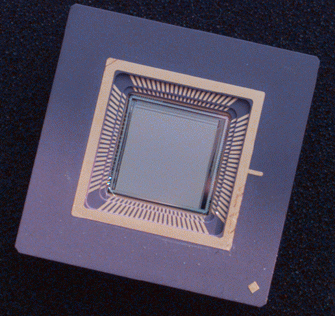
Our contribution to the conference exhibition will demonstrate a digital camera
application of the N128 128x128 pixel image sensor with analog neural preprocessing.
The chip was designed in our working group using an analog 1um CMOS technology. It contains a two-dimensional neural network with next-neighbour connectivity and optical input capable of low-pass filtering of images combined with contrast enhancement, binarisation or segmentation in the spatial domain.
The basic neuron cell is implemented as a fully differential current-mode circuit. The parameters of the neurons (gain and linearity of the transfer function, self-feedback, coupling strength of photodetector input and next-neighbour output) are adjustable by external bias currents. By varying these parameters, the behaviour of the network changes from a linear spatial low-pass filter with variable diffusion length to binarisation or segmentation. The neural network circuits can be operated in weak inversion for low power dissipation and/or moderate or strong inversion for a larger signal to pattern-noise ratio. The neuron outputs are read out via differential
switched-capacitor column preamplifiers and analog output buffers driving an external AD-converter.
A UNIX-workstation (or PC) controls the bias of the neuron matrix chip and reads and displays the video data stream of the AD-converter. The chip is mounted in a camera body. Image acquisition and preprocessing capabilities will be demonstrated.
G. Frank, G. Hartmann, M. Schaefer, C. Wolff,
Department of Electrical and Electronical Engineering, University of Paderborn, Germany
''SPIKE128K - A digital hardware accelerator for
the simulation of pulse-coded networks''
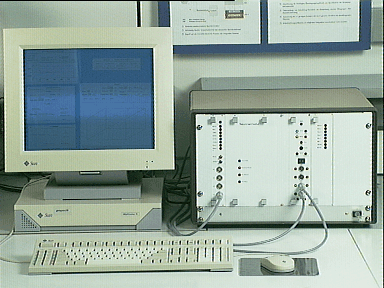
Our exhibition demonstrates the efficiency of the digital hardware accelerator, called
Spike128K. The hardware system has been optimized with regard to speeding up the
simulation of large pulse-coded neural networks. The Spike128K-system contains 128K
model-neurons
which can be connected arbitrarily with a total amount of 16M synaptic
weights. To simulate larger pulse-coded neural networks several systems can be
crosslinked. Control information as well as stimulation data are fed into the system
by serveral transputer links which are connected to a SUN SPARC - workstation.
The performance of the system will be demonstrated by synchronization mechanisms
of pulse-coded neural networks. The simulation of synchronization effects with
biologically inspired pulse-coded neural networks seems to be a suited example,
since synchronized oscillations have also been detected in the visual cortex of
cats and monkeys to link certain features of the visual scene.
Dupal Bernd, Sagerl Martina,
Institut für Gestaltungs- und Wirkungsforschung, TU Wien, Austria
''Darwin98 - Dynamisches ARtifizielles Wiener ImpulsneuronenNetz''
The presented program package simulates networks of spiking neurons
for the research of excitation and learning processes. The program runs
on a common pentium PC with 16 MB of RAM under MS-DOS 5.0 (or higher)
with
SVGA-compatible graphics adapter. It contains many tools for the
creation
and modification of such networks with utilities for logging and
evaluation
of the generated results. A large amount of parameters can be adjusted
to provide the ability of a very flexible experimentation. The focus has
been laid on a powerful user-friendly graphical environment. Currently,
the program can maintain online any free-structured network of several
hundred neurons.
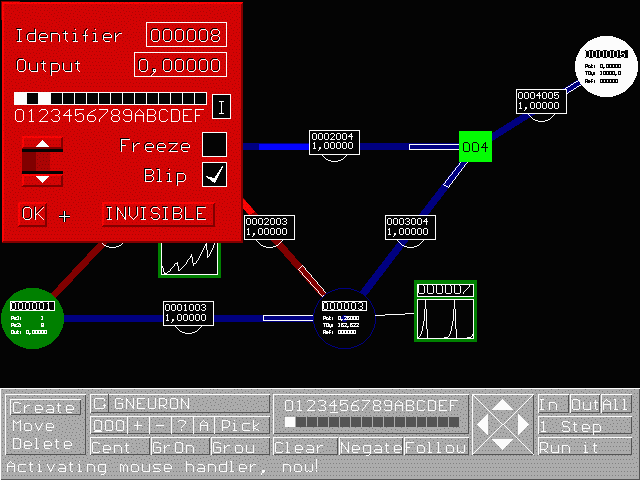
S. Neußer, B. Friebe, Institute of Microelectronics Stuttgart
(IMS), Germany
SAND Neural Processor and PCI Neuroboard
SAND (Simply-Applicable Neural Device) is a neural processor based upon
the principle of a systolic array. Four parallel processor elements form
the heart of this array. Each processor element has a multiplier and two
adders. With these elements the scalar product and the vector distance
can be calculated. A post-processing module allows the determination of
the largest and smallest output activity. The following types and sizes
of neural networks are supported by SAND:
- multilayer perceptrons (MLP), 512-64-64-64-64 (I-H-H-H-O)
- radial basis function networks (RBF), 512-64-64-64-64 (I-H-H-H-O)
- Kohonen Feature maps, 512-256 (I-O)
Very few external peripheral components are necessary for the operation
of SAND. A weight store RAM, a look-up table RAM for the non-linear transfer
function, and a FIFO for temporary data storage are needed. The memory
management and the control of the SAND is being performed by a sequencer
component (FPGA), which provides a simple macro command set.
With a maximum clock frequency of fmax = 50 MHz SAND achieves a performance
of 200 MCPS. Multiple SAND chips may be connected in parallel in order
to obtain a further increase in performance. SAND has been designed in
a co-operation between the IMS and the Forschungszentrum Karlsruhe.
The PCI neuroboard contains up to four SAND chips. Therefore the overall
peak performance increases to 800 MCPS. The board uses a standard PCI-Interface
and can excellently be used to accelerate network types mentioned above.
The PCI board has been designed by the Forschungszentrum Karlsruhe and
the distributor INCO Systeme GmbH. Neural simulators for UNIX operation
systems and Windows 95/NT are available as well as low level C interfaces.
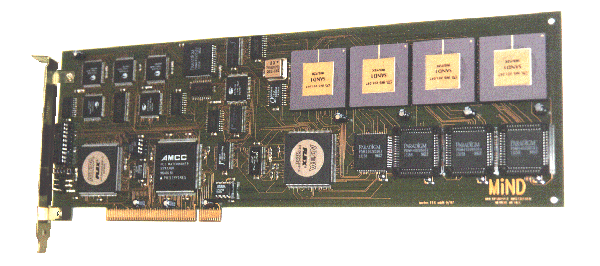
S. Neußer, B. Friebe, Institute of Microelectronics
Stuttgart (IMS), Germany
SIOP2 Neurochip and SCSI Neuroboard
The neurochip SIOP2 (Serial Input Output Parallel device) is an universal
neural controller for high data processing rates. On the chip a feedforward
network with RAM weights and a quadratic transfer function has been implemented
in fully parallel hardware. With the internal layout elements synapse,
dendrite and neuron various network topologies with up to two hidden layers
can be configured. Due to the flexible architecture several neurochips
can be cascaded together to form more complex neural controllers. SIOP2
achieves a performance of 350 MCPS with a maximum clock frequency of fmax
= 50 MHz.
For prototyping purposes in scientific and industrial environments a
neuroboard with three SIOP2 chips has been designed in a co-operation between
the IMS Stuttgart and the GEMAC Chemnitz. Several feedforward network topologies
can be reconfigured on the board with an achievable performance of more
than 1 GCPS. The board provides a robust and fast SCSI-2 interface, a serial
V.24 interface, 16 A/D- and 8 D/A-converter channels. An automatic weight
and configuration initialisation is being executed in case of a reset or
power-on. Together with the analog interface a standalone system operation
is supported. The following list gives the maximum configurations available
on the neuroboard:
- 10 x 40 x 5 x 9
- 20 x 20 x 10 x 9
- 40 x 10 x 10 x 9
- 40 x 15 x 9
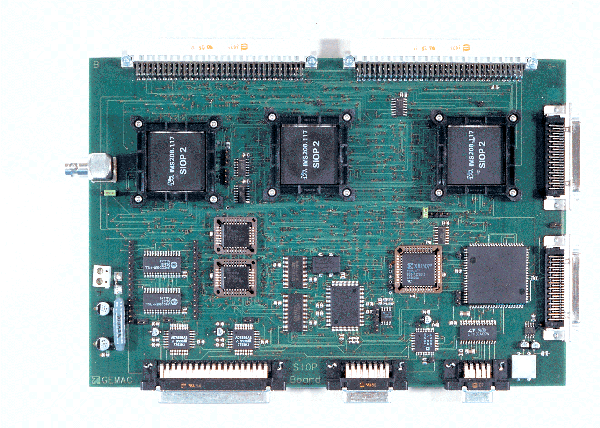
Conference Location:
The Conference will take place at University of Technology Dresden,
Faculty of Electrical Engineering, Helmholtzstr. 18, Barkhausenbau,
Room: Schönfeldsaal
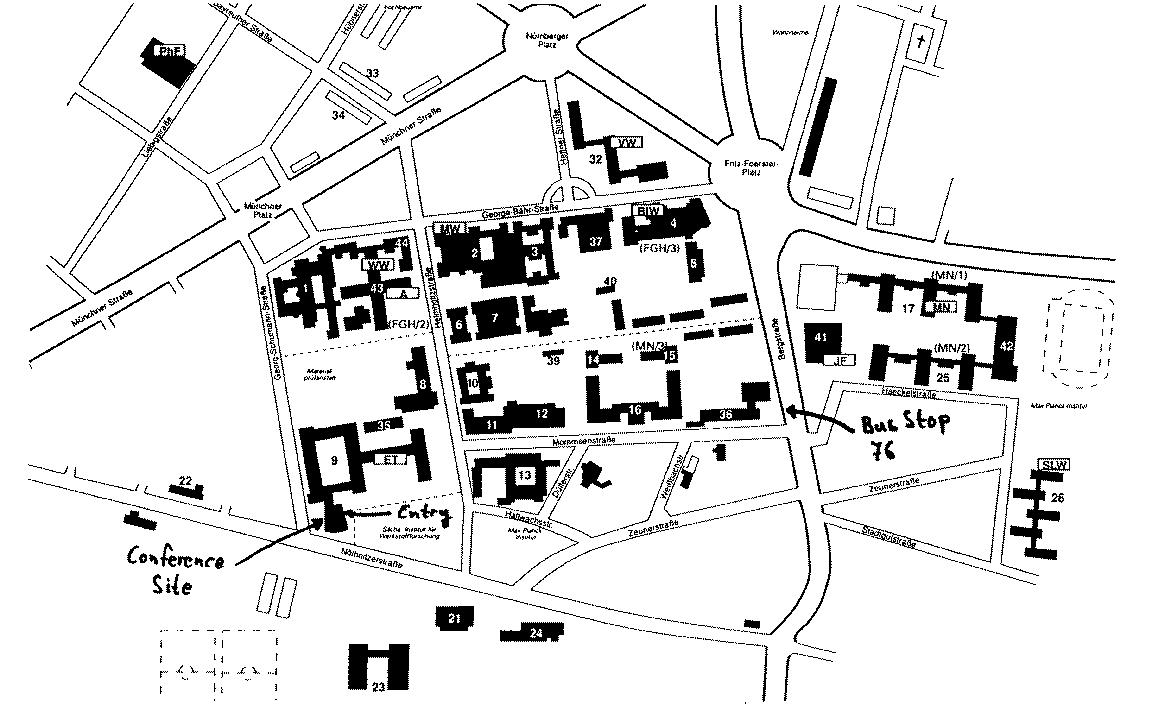
The conference site can most conveniently be reached by taxi or by
Bus 76 from central station. Leave at stop Mommsenstrasse. Alternatively,
tram 5 or 3 from central station can be used. Leave at stop Nürnberger
Platz.
Travel Information:
For overseas visitors, Dresden can most conveniently be reached
by plane via the Dresden airport. From the airport a shuttle bus
service (Airliner) is available, that takes passengers to central
station and several other stops down town. Most hotels can easily
be reached from the Airliner stops. Fare is about 12,- DM, schedule
depends on arrival time, departure is right in front of the arrival
terminal, tickets are available from the driver.
For travel in Dresden trams and busses can
conveniently be used with a one day or a week ticket.
The conference site can for instance be reached by
Bus 76 or tram 5 or 3 from central station.
Besides, quite a lot of scenic spots can be
easily reached by Dresden trams and busses.
For national and european visitors train or night train to Dresden
is a reasonable alternative to travelling by plane. Travellers will arrive
at central station or station Neustadt. From the latter, a convenient
local train connection to central station is available. From central
station you can proceed by bus or tram. Quite a number of big down town
hotels are in easy reach on foot from central station at Prager Strasse
and St. Petersburger Strasse.
Climate in September is still agreeable with temperatures in the range
of 15-23 degrees Celsius. However, rain protection should be included
in the travel equipment.
Dresden and Surroundings:
Some of the following information is only available in German.
This list will be updated as soon as equivalent information in English
is available.
For further information contact the:
Organizing Committee and Conference Secretariat:
Doz. Dr. A. König , Dr. S. Schmidt, J. Wieczorek, and KSTU Dresden GmbH
MICRONEURO'97 Conference Secretariat
Chair of Electron Devices and Integrated Circuits
Department of Electrical & Electronic Engineering
University of Technology Dresden
D-01062 Dresden
Tel.: +49 351 463 2805
Fax: +49 351 463 7260
Email:mneuro97@iee.et.tu-dresden.de
 University of Technology Dresden
University of Technology Dresden 
 University of Technology Dresden
University of Technology Dresden 





